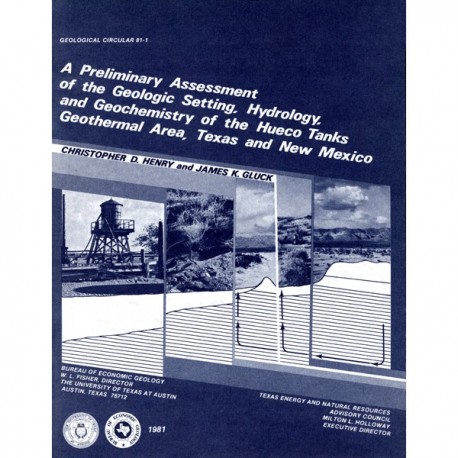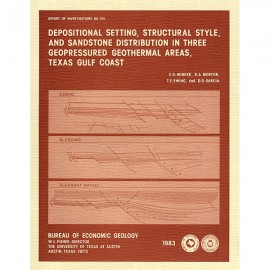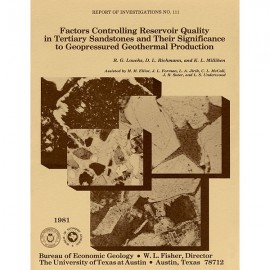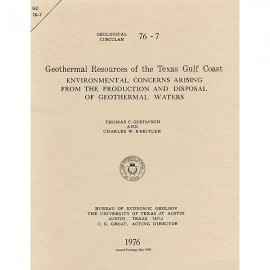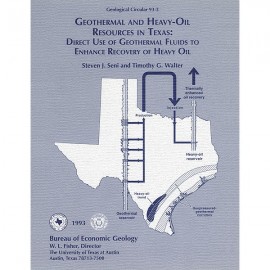Geological Circulars
-
Books & Reports
- Reports of Investigations
- Guidebooks
- Udden Series
- Geological Circulars
- Down To Earth
- Atlases of Major Oil and Gas Reservoirs
- Texas Memorial Museum Publications
- Environmental Geologic Atlas of the Texas Coastal Zone
- Mineral Resource Circulars
- Other Reports
- Seminars and Workshops
- Handbooks
- Submerged Lands of Texas
- Symposia
- Annual Reports
- Open File Reports
-
Maps & Cross Sections
- Thematic Maps
- Miscellaneous Maps, Charts & Sections
- Geologic Atlas of Texas
- STATEMAP Project Maps
- Geologic Quadrangle Maps
- Cross Sections
- Highway Geology Map
- Energy and Mineral Resource Maps
- Shoreline Change and Other Posters
- Wilcox Group, East Texas, Geological / Hydrological Folios
- Bouguer Gravity Atlas of Texas
- River Basin Regional Studies
- Featured Maps
- Posters
- Teachers & the Public
-
Geological Society Publications
- Gulf Coast Association of Geological Societies
- Alabama Geological Society
- Austin Geological Society
- Corpus Christi Geological Society
- Houston Geological Society
- Lafayette Geological Society
- Mississippi Geological Society
- New Orleans Geological Society
- South Texas Geological Society
- GCS SEPM Publications
- Historic BEG & UT Series
A Preliminary Assessment of the Geologic Setting, Hydrology, and Geochemistry of the Hueco Tanks Geothermal Area, Texas
GC8101
A free, digital version of this publication can be found on: Texas ScholarWorks
GC8101. A Preliminary Assessment of the Geologic Setting, Hydrology, and Geochemistry of the Hueco Tanks Geothermal Area, Texas and New Mexico, by C. D. Henry and J. K. Gluck. 48 p., 9 figs., 2 tables, 1981. ISSN: 00829-3301. Print.
To purchase this publication as a PDF download, please order GC8101D.
ABSTRACT
The Hueco Tanks geothermal area contains five known but now inactive hot wells (50° to 71°C). The area trends north-south along the east side of Tularosa-Hueco Bolson astride the Texas-New Mexico border approximately 40 km northeast of El Paso. Because of its proximity to El Paso, geothermal water in the Hueco Tanks area could be a significant resource. Hueco Bolson is an asymmetric graben. Greatest displacement along boundary faults is on the west side adjacent to the Franklin Mountains. Faults, probably with less displacement, also form an irregular boundary on the east side of the bolson. Several probable faults may allow the rise of thermal waters from depth. Ground water in the central part of Hueco Bolson flows southward to the Rio Grande. However, four of the five hot wells occur in a ground-water trough along the eastern margin of the bolson. The trough may be bounded by one of the postulated faults serving as a barrier to ground-water flow. Data on permeability of potential reservoir rocks, including basin fill and fractured bedrock, suggest that they may be sufficiently permeable for development of geothermal water. The concentration of dissolved solids in the geothermal waters varies from 1,100 to at least 12,500 mg/L, but most waters show high concentrations. They are Na-Cl-(SO4) waters similar in composition to nonthermal waters in basin fill. The composition probably results from contact with evaporite deposits either in basin fill or in Paleozoic bedrock. Shallow reservoirs reach maximum temperatures of about 80° to 110°C. Available data are too limited to evaluate adequately the resource potential of geothermal water in the Hueco Tanks area. A complete exploration program, including geological, hydrological, and geochemical investigation, is recommended.
Keywords: faults, geothermal, Hueco Tanks, Tularosa-Hueco Bolson, Hueco Bolson, Rio Grande, geochemistry, New Mexico, Texas
Citation
Henry, C. D., and Gluck, J. K., 1981, A Preliminary Assessment of the Geologic Setting, Hydrology, and Geochemistry of the Hueco Tanks Geothermal Area, Texas and New Mexico: The University of Texas at Austin, Bureau of Economic Geology, Geological Circular 81-1, 48 p.
